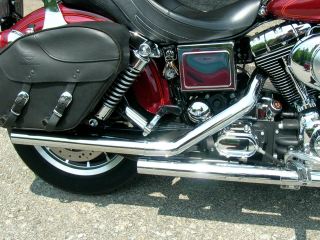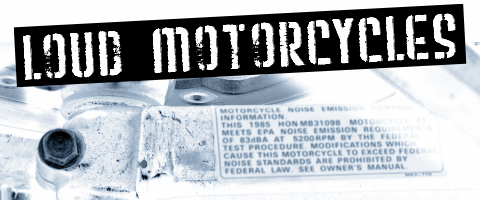Motorcycles
Summary
Motorcycles are an enjoyable and purposeful machine when operated properly. In the United States, motorcycles are built to federally mandated noise control standards. The reason why some motorcycles are loud is because riders modify the exhaust system or install an aftermarket exhaust system that is not street legal.
A roaring exhaust system can be heard and felt over a wide distance, rattle windows and travel through walls. Millions of people are adversely affected by motorcycle noise.
Riders who choose to ride with illegal exhaust systems ruin the image of the lifestyle and sport of motorcycling for others. Responsible riders and motorcycle clubs should advocate the use of legal exhaust systems.
Motorcycle riders with loud aftermarket exhaust systems often claim that "loud pipes save lives" - that they are more likely to notice the attention of distracted motorists when they are on the road. There is no study on record that demonstrates a correlation between the noise level of a motorcycle exhaust system and its ability to reduce accidents. Motorcycles are also equipped with horns, just like passenger vehicles.
Loud motorcycle exhaust systems produces low frequency sound that is non-directional and coming from the rear of the motorcycle where the exhaust is located. Since most two-vehicle accidents come from the front of the vehicle, the use of a loud exhaust system does nothing to alert other motorists of an oncoming motorcycle.
The National Highway Traffic Safety Administration (NHTSA) analyzes and reports on motorcycle accident data statistics and acts as a clearinghouse on motorcycle safety.
In their 2007 published report, 'Fatal Two-Vehicle Motorcycle Crashes' (DOT HS 810 834), motorcyclists were found to be overwhelmingly responsible for causing accidents with passenger vehicles. In nearly three-fourths of the two-vehicle motorcycle crashes involving passenger vehicles, the role of the motorcycle was recorded as the striking vehicle. Additionally, factors including alcohol impairment, invalid license, and speeding were more attributed to motorcycle riders.
Straight-Pipe Exhaust System

An exhaust system that no motorcycle manufacturer ever installed on a production motorcycle directly from the factory. Straight-pipes are designed to increase noise, and possess noise levels far in excess of current EPA manufacturing requirements.
Industry
The largest manufacturers of motorcycles are Harley-Davidson Motor Company (H-D), Suzuki, Kawasaki, Yamaha, Honda, and BMW. The largest manufacturers of aftermarket exhaust systems are Samson Motorcycle Products, Vance & Hines, Yoshimura, D&D, and Kerker.
The Motorcycle Industry Council (MIC), and Specialty Equipment Market Association (SEMA) are industry trade groups representing manufacturers, dealers and installers.
They have lobbied against proposed noise-pollution ordinances in communities across America. SEMA created the 'Congressional Automotive Performance and Motorsports Caucus' enlisting members of congress to support their agenda. They also enlist local motorcycle clubs to lobby on their behalf on political issues that might affect their industry.
With increasing negative news stories and noise code legislation targeted at the motorcycle community, H-D discontinued manufacturing non street-legal exhaust pipes using the brand name 'Screamin' Eagle.'
H-D had attempted to trademark the noise from its V-twin motorcycle engines. Ken Schmidt, a former H-D executive once described the sound of his product in three words: "Voice of God." He went on during a speech at a business conference, "Noise is good. Noise is the foundation of your business."
Some riders join motorcycle rights organizations (MROs) that lobby against motorcycle noise legislation. These organizations include the Motorcycle Riders Foundation, and American Motorcyclist Association (AMA). In many cities and states, there are groups that call itself ABATE. Depending on the chapter, the acronym may stand for 'American Brotherhood Aimed Towards Education' or 'American Brotherhood Against Totalitarian Enactments.'
Motorcycle Exhaust Noise In Boston
When a motorcycle comes from the factory, the exhaust system is EPA approved, but not for long. "We usually see 60 to 70 percent of riders change the pipes out," according to the general manager at a Boston Harley-Davidson dealership.
Legislation
The Environmental Protection Agency (EPA) sets noise emissions standards for motorcycle exhaust systems. The standard for street-legal exhaust noise emissions is 80 dB(a). All motorcycles are required to display an EPA stamp on the chassis and exhaust system. The EPA recognized that the intricacies of accurate field-testing are beyond the scope of law enforcement agencies. The EPA label match-up is designed as a regulatory measure for states and municipalities to control motorcycle noise.
Riders can legally buy and install aftermarket exhaust systems, however it is required to meet EPA noise emissions. Most aftermarket exhaust systems are not street-legal and intended for off-road or professional track use only.
The California Air Resources Board estimates that a motorcycle whose catalytic converter has been removed emits up to ten times the amount of smog forming pollutants. This is just one of many common modifications to emissions equipment, often intended to make the bike louder, that reduces air quality and increases noise pollution.
Affected residents dealing with the problem of motorcycle noise are actively lobbying their elected officials for better legislation and enforcement. Additionally, there is increasing motorcycle restrictions on public lands, private roads and gated communities.
Traditional rider destinations in cities such as Daytona, Myrtle Beach, Laconia have held public hearings aimed at banning annual motorcycle events. Some affected residents abandon their own homes during motorcycle rallies because of the deafening noise and traffic.
The AMA compromises over 300,000 members and more than 1,200 chartered clubs, with corporate representation from the motorcycle industry. Through sponsored events and organized campaigns, they mobilize their membership to lobby to defeat motorcycle noise legislation.
In 2002, after intense lobbying from the AMA and other MROs, the City of Albuquerque abandoned EPA stamp enforcement.
In 2007, in spite of vocal opposition, the City of Denver passed EPA stamp enforcement.
In 2008 and 2009, the New York City Council proposed legislation that would allow police officers to visually inspect parked motorcycles for the required EPA stamp.
In 2008, the City of Myrtle Beach passed EPA stamp enforcement and banned most motorcycle rallies. Affected residents claimed the noise, traffic congestion and unruly behavior was a serious problem. According to the Mayor of Myrtle Beach, John Rhodes, motorcycle rallies also drove away visitors. In early 2009, after intense lobbying by local businesses that cater to motorcycle tourism, the Myrtle Beach City Council repealed the legislation.
In 2009, the Boston City Council passed EPA stamp enforcement that imposes a $300 fine on riders caught with illegal exhaust pipes.
In 2009, Arvada, Colorado passed EPA stamp enforcement.
In 2009, Portland, Maine proposed EPA stamp enforcement. In 2010, the Maine State Legislature is considering EPA stamp enforcement.
In 2009, Green Bay, Wisconsin passed EPA stamp enforcement. Additionally, citizens can submit complaints of loud vehicles online that police officers can enforce if the vehicle is found to be in violation.
In 2010, California passed SB 435 that aims to increase enforcement of current anti-tampering and noise-level statutes for motorcycles. It would require that motorcycles maintain their federally required emissions equipment (on both original, and aftermarket exhaust systems), including a readily visible EPA stamp certifying compliance. These regulations gives law enforcement the ability to cite violations under the CA Vehicle Code, using a readily visible and unalterable stamp, already required by Federal regulation. The law applies to 2013 and newer model-year vehicles and is not retroactive to older motorcycles.
In response to increasing legislation in support of EPA stamp enforcement around the country, the AMA 'Motorcycle Sound Working Group' was created.
They organized a 'National Summit on Motorcycle Sound' comprised of representatives from motorcycle manufacturers, the aftermarket industry, and racing promoters to create alternative model legislation. In 2009, the Society of Automotive Engineers (SAE) developed a new street motorcycle measurement procedure, called J2825, "Measurement of Exhaust Sound Pressure Levels of Stationary On-Highway Motorcycles."
The SAE J2825 standard, prepared by the SAE 'Motorcycle Technical Steering Committee', recommends a decibel limit of 92 to 100 dB(a) for motorcycles. As decibel levels are measured logarithmically, a motorcycle would pass a vehicle inspection at over ten-times the current federal limits for noise emissions.
It requires police officers to use a sound meter at an angle from a discreet distance of the exhaust pipe while the motorcycle operator slowly increases the RPM at idle.
In communities where police officers are mandated to use sound meters to determine motorcycle noise, the result is no meaningful enforcement. The meters are expensive, it must be maintained and calibrated, the officer must be trained in its use and follow exact protocols. Adverse field conditions (such as vehicle traffic on roadways) make it difficult to get an accurate measurement. The summons is often challenged in court and dismissed.
The automotive and motorcycle industry is neither qualified nor acting in the best interest on the issue of public health in relation to vehicle noise emissions and enforcement. The advocacy of SAE J2825 is designed to game the system with legislation that is unenforceable.
Another enforcement measure is called 'plainly audible standard' that allows an officer to determine excessive noise levels. In New York City, offenders can be cited if the motorcycle exhaust noise is plainly audible at 200 feet. Since passed in 2007 as part of a revised noise code, it has proven to be ineffective.






